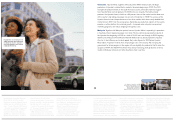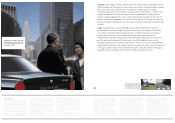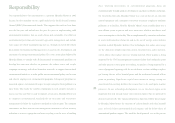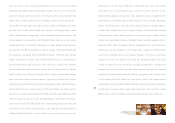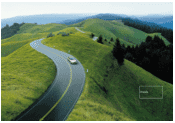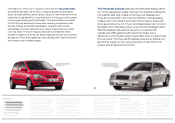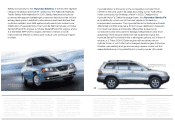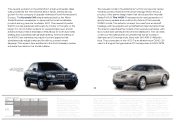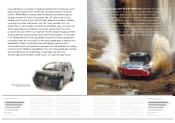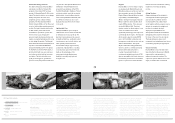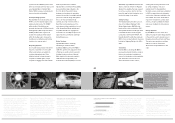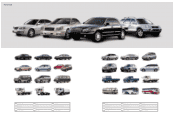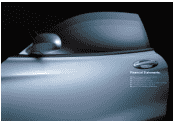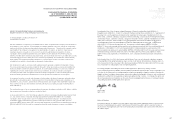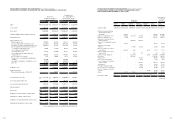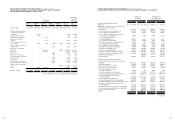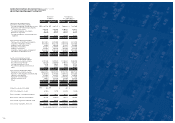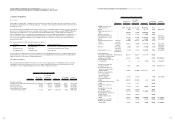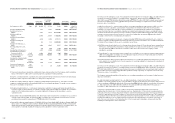Hyundai 2002 Annual Report Download - page 20
Download and view the complete annual report
Please find page 20 of the 2002 Hyundai annual report below. You can navigate through the pages in the report by either clicking on the pages listed below, or by using the keyword search tool below to find specific information within the annual report.
Alternative Energy Vehicles
The State of Hawaii and Hyundai Motor
embarked on an Electric Vehicle (EV)
program in November 2000 and now
operate 15 Hyundai Santa Fe EVs on the
island. The electric vehicles use a storage
battery that powers the motor and
peripheral systems, without emitting
pollutants. The Hyundai Click Hybrid
Electric Vehicle (HEV) is 30 to 40 percent
more fuel efficient than gasoline-powered
models. The hybrid electric vehicle relies
on both electric power and internal
combustion to operate its systems. The
electric motor assists the gasoline-
powered engine during acceleration and
regains energy during braking, while using
no fuel during idle periods. The Hyundai
Santa Fe H2 Fuel Cell Vehicle (FCV) took
top honors at the Michelin Bibendum
Environmental Rally in 2001. The Santa
Fe H2 FCV won the best FCV award, a
gold medal in both emissions and noise,
and a silver medal in both fuel economy
and slalom. The fuel cell vehicle uses
hydrogen and oxygen to generate the
power it needs, and produces water as its
only emission. The Hyundai Santa Fe Fuel
Cell Electric Vehicle (FCEV) finished
among the top carmakers at the 2002
Fuel Cell Road Rally in California. The fuel
cell electric vehicle, much like an electric
hybrid vehicle, is assisted by an electric
motor. The Hyundai Santa Fe FCEV, with
its 5,000psi fuel tank, can store more
hydrogen than any other fuel cell vehicle
in the world.
Lightweight Cars
The Hyundai Tiburon sports coupe in
1997 became our first show car built with
an all-aluminum monocoque body. The
aluminum monocoque provides superior
strength and lightness, particularly useful
in performance cars, fuel cell vehicles and
other specialty vehicles that must
accommodate a large engine or heavy
components. Hyundai Motor is working
on an aluminum space frame body that
builds on the advantages of the
monocoque body by allowing more
flexibility in assembly and improved
strength in use.
Engines
Hyundai Motor's newest midsize engines,
co-developed with DaimlerChrysler and
Mitsubishi, will power select cars from the
three companies as part of the Global
Engine Alliance. Hyundai Motor has lead
responsibility in the Global Engine
Alliance development program. Hyundai
Motor's high-tech direct injection diesel
engine (HTI) generates 115ps of power
at only 93.5dBA of NVH. The direct
injection system for diesel engines is one
of the most advanced of its kind,
significantly increasing power output over
conventional diesel engines. The Hyundai
direct injection gasoline engine (HIDI)
runs in both stratified combustion and
homogenous combustion modes, and can
achieve ultra-lean burn. The system
adjusts combustion during partial load,
when less power is needed, and during
full load, when maximum power is
needed. Our patented H-matic or
continuously variable transmission (CVT)
gives no perceptible shift shock, improves
fuel efficiency and increases acceleration
by 8 to 11 percent over other automatic
transmissions. The transmission is being
installed in newer Hyundai Sonata
models.
Airbag Systems
Advanced airbags will be installed in
select Hyundai models beginning this
year and will be installed in all other
models by 2005. This safety feature
works together with passenger presence
detector to recognize the weight and
position of occupants to adjust
deployment. Hyundai Motor has
developed the world's first head-thorax
airbag that protects both the head and
the chest in the event of a side impact.
The larger airbag can also prevent
occupants from being thrown from the car
or from being injured by foreign objects.
Chassis Systems
Hyundai Motor's first-of-its-kind Active
Geometry Control Suspension (AGCS)
represents the next generation in
advanced suspension systems. The
suspension system deflects forces at an
angle, not head-on like conventional
39
centers managing sales and services, Hyundai
will continue to increase its sales based on the
trust of its customers and improved brand
image as a global automobile manufacturer.
Marketing
Hyundai Motor Company announced its
plans to become one of the top five global
automobile makers by 2010, not only in terms
of quantity but also in all aspects including
profits, quality and brand value.
To reach this goal, Hyundai branched off its
marketing division from its sales department
in 2002 and launched the marketing
headquarters at the beginning of 2003,
merged with the marketing department of Kia
Motor. At present, the company has divided
the global market into major segments,
namely North America, Europe, Asia Pacific,
Middle East, China and India, to implement
site-intensive marketing.
In the North American market where
competition among global automobile
manufacturers has become exceedingly fierce,
Hyundai has received highly favorable reviews
on all of its products from the local press as
well as its customers for its improvement in
quality and continuous marketing efforts
including the highly successful campaign
offering astounding warranty periods.
In the continuously growing Middle East and
East Asian markets, Hyundai has seen a steady
increase in sales as it tailors its marketing
efforts on the economical and cultural
characteristics of the region. The company
will work to improve its sales as well as
customer satisfaction in those promising areas
going forward. Realizing the importance of
regional aspects, the marketing headquarters
of Hyundai Motor sent out marketing
specialists to its overseas divisions to better
understand and address the exact needs of the
specific market. The company’s devotion in
‘Glocalization’ propelled its growth to become
the seventh automobile company in the
world.
Hyundai Motor Company is also improving
its brand image to match its vision as one of
the top five global automobile companies.
Since the late 1990s, Hyundai realized the
importance of its brand image as an intangible
asset and replaced its C.I.P to give a more
futuristic impression. Through aggressive
marketing campaigns and various sports
1. The Hyundai Santa Fe Fuel Cell Electric Vehicle placed
well at the Environmental Rally in California. 2. The all-
aluminum body of the Hyundai Getz model car is lightweight
and remarkably strong, improving fuel efficiency,
performance and safety on the road. 3. Hyundai Motor
powerplants provide the right balance of fuel efficiency,
performance and cost effectiveness, through a complete
range of outputs. 4. Side airbags and advanced curtain
airbags will be introduced in some newer Hyundai models.
5. Select Hyundai Motor chassis systems incorporate front
MacPherson struts and rear dual link setup to provide
superior handling and comfort.
5 4 3
2 5 4 3
2
1


